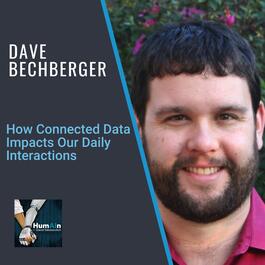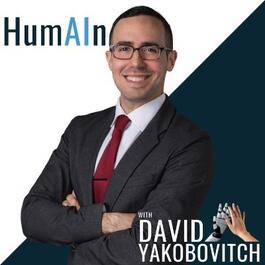
Dave Bechberger: How Connected Data Impacts Our Daily Interactions
Dave Bechberger: How Connected Data Impacts Our Daily Interactions [Audio] Podcast: Play in new window | Download Subscribe: Google Podcasts | Spotify | Stitcher | TuneIn | RSS Dave Berchberger is a Senior Graph Architect at Amazon Web Services (AWS). He is known for his expertise in distributed data architecture being a thought leader in graph databases, and the co-author of Graph Databases in Action by Manning Publications. Dave uses his 20+ yrs experience working on and managing teams delivering full-stack software solutions to take a holistic approach to solve complex data problems. Episode Links: Dave Bechberger’s LinkedIn: https://www.linkedin.com/in/davebechberger/ Dave Bechberger’s Twitter: https://twitter.com/bechbd?s=20 Dave Bechberger’s Website: https://www.manning.com/books/graph-databases-in-action?a_aid=bechberger Podcast Details: Podcast website: https://www.humainpodcast.com Apple Podcasts: https://podcasts.apple.com/us/podcast/humain-podcast-artificial-intelligence-data-science/id1452117009 Spotify: https://open.spotify.com/show/6tXysq5TzHXvttWtJhmRpS RSS: https://feeds.redcircle.com/99113f24-2bd1-4332-8cd0-32e0556c8bc9 YouTube Full Episodes: https://www.youtube.com/channel/UCxvclFvpPvFM9_RxcNg1rag YouTube Clips: https://www.youtube.com/channel/UCxvclFvpPvFM9_RxcNg1rag/videos Support and Social Media: – Check out the sponsors above, it’s the best way to support this podcast – Support on Patreon: https://www.patreon.com/humain/creators – Twitter: https://twitter.com/dyakobovitch – Instagram: https://www.instagram.com/humainpodcast/ – LinkedIn: https://www.linkedin.com/in/davidyakobovitch/ – Facebook: https://www.facebook.com/HumainPodcast/ – HumAIn Website Articles: https://www.humainpodcast.com/blog/ Outline: Here’s the timestamps for the episode: (00:00) – Introduction (01:29) – Corporate environments need to be able to help solve certain types of problems that traditional relational databases or other data technologies are not very good at solving. The new approach is to build out high-performance data platforms on top of a mix of technologies, focused around solving them with graphic, graph database technologies. (02:53) – Graphs are the mathematical construct of a graph. It's really about networks, connected data of different people connected to other people or things of that nature. It's about building out networks and using those connections to be able to answer specific types of questions and draw insight and information out of that data that isn't necessarily available from other technologies. (06:49) – Fraud is another canonical use case, because it is all about figuring out connections and patterns within data, to be able to discern whether this activity is fraudulent or not. (08:32) – Other technologies don't do a great job linking together entities in such a way that those links and those connections are also treated as first-class citizens inside that data. Graphs bring those connections in your data up to being “first-class citizens”. (09:29) – With a graph, those connections are brought up and given first class status in the languages and queries that you run. It's called traversing them, to be able to move across them, to be able to drive insight from how those connections are made and how those connections basically connect this network of data together. (12:38) – Using Graphs makes developers able to not only process data in a real-time transactional mode, but being able to use those along with something like graph type analytics, and then use that in conjunction with AI and ML technologies to augment data back into your graph in order to provide a better real-time user experience. (14:32) – Any enterprise build or any consumer service build is really about creating a better, faster and easier to use experience for your customers. Those are really the driving forces behind any kind of business initiative. Graphs is one of those technologies. (16:38) – There's certain types of analytics that can be run on top of graphs that are very helpful to be used as inputs into machine learning algorithms of different types. Some examples show working in a fraud area. (18:20) – Machine learning in general and graphs-based machine learning specifically, is this concept of a graph neural network, which is basically a neural network that instead of taking only vector features as input, it actually takes in a graph itself. So, graphs as an input to be able to create predictive models on the output. It's building a graph of different connected objects inside the algorithm itself as it's training and learning. (20:33) – To really be able to build graph-based stack applications or applications on top of graph databases, you don't necessarily need to have all of that very academic understanding. And being able to condense that down into a system that helps people start to think about problems that way was really the purpose with Graph Databases in Action by Manning Publications. (25:54) – The biggest ways graphs are being adopted today is used in conjunction with other technologies, be those relational databases or document databases or key value stores or whatever other technologies that are out there. (28:18) – Graphs is one of those technologies that is definitely a double-edged sword because you're able to drive insights and you'll be able to see connections between things. People could use those connections in nefarious type ways. Advertising Inquiries: https://redcircle.com/brands Privacy & Opt-Out: https://redcircle.com/privacy
From "HumAIn Podcast"




Comments
Add comment Feedback